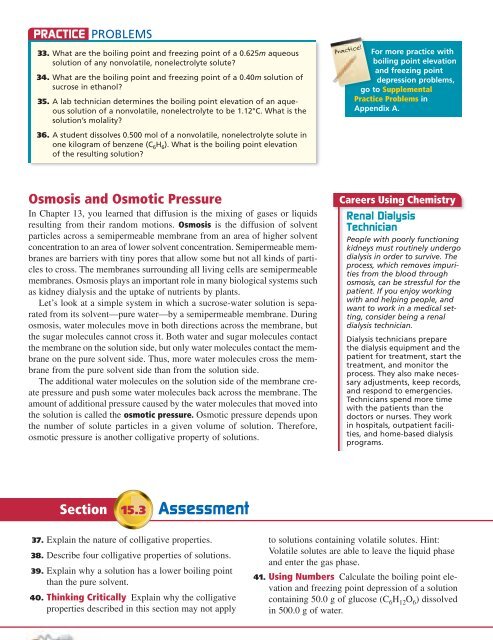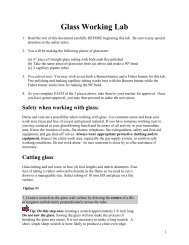Chapter 15: Solutions - Weironline.net
Chapter 15: Solutions - Weironline.net
Chapter 15: Solutions - Weironline.net
Create successful ePaper yourself
Turn your PDF publications into a flip-book with our unique Google optimized e-Paper software.
PRACTICE PROBLEMS<br />
33. What are the boiling point and freezing point of a 0.625m aqueous<br />
solution of any nonvolatile, nonelectrolyte solute?<br />
34. What are the boiling point and freezing point of a 0.40m solution of<br />
sucrose in ethanol?<br />
35. A lab technician determines the boiling point elevation of an aqueous<br />
solution of a nonvolatile, nonelectrolyte to be 1.12°C. What is the<br />
solution’s molality?<br />
36. A student dissolves 0.500 mol of a nonvolatile, nonelectrolyte solute in<br />
one kilogram of benzene (C 6H 6). What is the boiling point elevation<br />
of the resulting solution?<br />
Osmosis and Osmotic Pressure<br />
In <strong>Chapter</strong> 13, you learned that diffusion is the mixing of gases or liquids<br />
resulting from their random motions. Osmosis is the diffusion of solvent<br />
particles across a semipermeable membrane from an area of higher solvent<br />
concentration to an area of lower solvent concentration. Semipermeable membranes<br />
are barriers with tiny pores that allow some but not all kinds of particles<br />
to cross. The membranes surrounding all living cells are semipermeable<br />
membranes. Osmosis plays an important role in many biological systems such<br />
as kidney dialysis and the uptake of nutrients by plants.<br />
Let’s look at a simple system in which a sucrose-water solution is separated<br />
from its solvent—pure water—by a semipermeable membrane. During<br />
osmosis, water molecules move in both directions across the membrane, but<br />
the sugar molecules cannot cross it. Both water and sugar molecules contact<br />
the membrane on the solution side, but only water molecules contact the membrane<br />
on the pure solvent side. Thus, more water molecules cross the membrane<br />
from the pure solvent side than from the solution side.<br />
The additional water molecules on the solution side of the membrane create<br />
pressure and push some water molecules back across the membrane. The<br />
amount of additional pressure caused by the water molecules that moved into<br />
the solution is called the osmotic pressure. Osmotic pressure depends upon<br />
the number of solute particles in a given volume of solution. Therefore,<br />
osmotic pressure is another colligative property of solutions.<br />
Section <strong>15</strong>.3 Assessment<br />
37. Explain the nature of colligative properties.<br />
38. Describe four colligative properties of solutions.<br />
39. Explain why a solution has a lower boiling point<br />
than the pure solvent.<br />
40. Thinking Critically Explain why the colligative<br />
properties described in this section may not apply<br />
chemistrymc.com/self_check_quiz<br />
Practice!<br />
For more practice with<br />
boiling point elevation<br />
and freezing point<br />
depression problems,<br />
go to Supplemental<br />
Practice Problems in<br />
Appendix A.<br />
Renal Dialysis<br />
Technician<br />
People with poorly functioning<br />
kidneys must routinely undergo<br />
dialysis in order to survive. The<br />
process, which removes impurities<br />
from the blood through<br />
osmosis, can be stressful for the<br />
patient. If you enjoy working<br />
with and helping people, and<br />
want to work in a medical setting,<br />
consider being a renal<br />
dialysis technician.<br />
Dialysis technicians prepare<br />
the dialysis equipment and the<br />
patient for treatment, start the<br />
treatment, and monitor the<br />
process. They also make necessary<br />
adjustments, keep records,<br />
and respond to emergencies.<br />
Technicians spend more time<br />
with the patients than the<br />
doctors or nurses. They work<br />
in hospitals, outpatient facilities,<br />
and home-based dialysis<br />
programs.<br />
to solutions containing volatile solutes. Hint:<br />
Volatile solutes are able to leave the liquid phase<br />
and enter the gas phase.<br />
41. Using Numbers Calculate the boiling point elevation<br />
and freezing point depression of a solution<br />
containing 50.0 g of glucose (C6H12O6 ) dissolved<br />
in 500.0 g of water.<br />
<strong>15</strong>.3 Colligative Properties of <strong>Solutions</strong> 475




